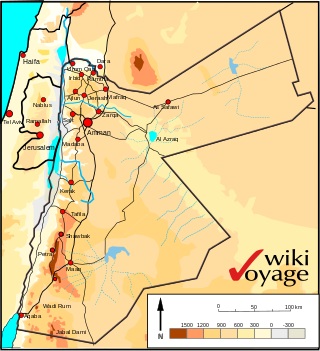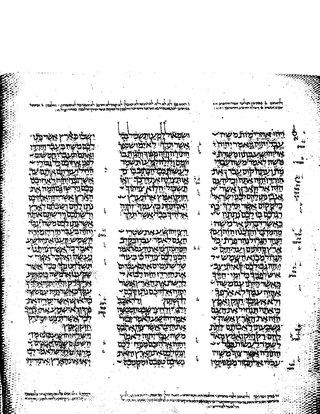The deuterocanonical books, meaning "Of, pertaining to, or constituting a second canon," collectively known as the Deuterocanon (DC), are certain books and passages considered to be canonical books of the Old Testament by the Catholic Church, the Eastern Orthodox Church, the Oriental Orthodox Church, and the Church of the East. In contrast, modern Rabbinic Judaism and Protestants regard the DC as Apocrypha.
The Old Testament (OT) is the first division of the Christian biblical canon, which is based primarily upon the 24 books of the Hebrew Bible, or Tanakh, a collection of ancient religious Hebrew and occasionally Aramaic writings by the Israelites. The second division of Christian Bibles is the New Testament, written in Koine Greek.
Zaanaim, Zaanannim or Bezaanaim is a place name applied to one or two locations in the Hebrew Bible. According to Serge Frolov (2013), its location "cannot be determined with any degree of certainty."

Mount Nebo is an elevated ridge located in Jordan, approximately 700 metres (2,300 ft) above sea level. Part of the Abarim mountain range, Mount Nebo is mentioned in the Bible as the place where Moses was granted a view of the Promised Land before his death. The view from the summit provides a panorama of the West Bank across the Jordan River valley. The city of Jericho is usually visible from the summit, as is Jerusalem on a very clear day. The biblical town of Nebo, now known as Khirbet al-Mukhayyat, is located 3.5 km away.

Mount Seir is the ancient and biblical name for a mountainous region stretching between the Dead Sea and the Gulf of Aqaba in the northwestern region of Edom and southeast of the Kingdom of Judah. It may also have marked the older historical limit of Ancient Egypt in Canaan. A place called "Seir, in the land of Shasu", thought to be near Petra, Jordan, is listed in the temple of Amenhotep III at Soleb.
Aroer is the name of two biblical cities in the Transjordan, in what is today the Kingdom of Jordan.
Some translators of the biblical book of Deuteronomy translate Pisgah as a name of a mountain, usually referring to Mount Nebo. The word פִּסְגָּה literally means "summit". The region lies directly east of the Jordan River and just northeast of the Dead Sea. Mount Nebo is the highest among a handful of Pisgah summits; an arid cluster of hilltops on the western edge of the Trans-Jordanian Plateau. Arabic names for Pisgah include: Fasga (Phasga), Jabal Siyāgha, Rās as-Siyāgha and Rujm Siyāgha.

The Wilderness of Zin or the Desert of Zin is a geographic term with two meanings, one biblical and one modern Israeli, which are not necessarily identical.
Kibroth Hattaavah or Kibroth-hattaavah is one of the locations which the Israelites passed through during their Exodus journey, recorded in the Book of Numbers. It was at this place, according to the biblical narrative, that the Israelites loudly complained about constantly eating only manna, and that they had enjoyed a much more varied diet, of fish, vegetables, fruit and meat, when they lived in Egypt; the text states that this led Moses, in despair, to cry out to Yahweh, who then promised them so much meat that 'they would vomit it through their nostrils'. The narrative goes on to tell of a huge number of quails brought by the winds to both sides of the Israelite encampment, which the people gathered. Modern translations imply that Yahweh sent the plague as they were chewing the first meat that fell.
Nebo is a town name mentioned in several passages of the Hebrew Bible. It is used for two towns, one in the territory assigned in the Bible to the Tribe of Reuben, and another in that of the Tribe of Judah.

Mount Sinai is the mountain at which the Ten Commandments were given to Moses by God, according to the Book of Exodus in the Hebrew Bible. In the Book of Deuteronomy, these events are described as having transpired at Mount Horeb. "Sinai" and "Horeb" are generally considered by scholars to refer to the same place.
According to the Book of Numbers, Taberah is one of the locations which the Israelites passed through during their Exodus journey. The biblical narrative states that the place received its name, which means the pӀace of burning, because the fire of the LORD had burned there in anger because of their continued complaints. The text states that the fire first burned at the outskirts of the Israelite camp, killing some of those who lived on the edge of the group, but it was extinguished when Moses prayed on the people's behalf.
The Old Testament is the first section of the two-part Christian biblical canon; the second section is the New Testament. The Old Testament includes the books of the Hebrew Bible (Tanakh) or protocanon, and in various Christian denominations also includes deuterocanonical books. Orthodox Christians, Catholics and Protestants use different canons, which differ with respect to the texts that are included in the Old Testament.
Jazer was a city east of the Jordan River, in or near Gilead, inhabited by the Amorites. It was taken by a special expedition sent by Moses to conquer it towards the end of the Israelites' Exodus journey from Egypt. From the Septuagint it appears that Jazer was on the border of Ammon. As an important city it gave its name to the whole of the surrounding territory - a "Sea of Jazer" is mentioned in Jeremiah xlviii. 32.

The Plains of Moab are mentioned in three books of the Hebrew Bible as an area in Transjordan, stretching along the Jordan "across from Jericho", and more specifically "from Beth Jeshimoth to Abel Shittim". Here is the last Station of the Exodus and the place from which Moses climbs up on Mount Nebo "to the top of Pisgah", where he dies.

Joshua 12 is the twelfth chapter of the Book of Joshua in the Hebrew Bible or in the Old Testament of the Christian Bible. According to Jewish tradition the book was attributed to Joshua, with additions by the high priests Eleazar and Phinehas. However, modern scholars view it as part of the Deuteronomistic History, which spans the books of Deuteronomy to 2 Kings, which are attributed to nationalistic and devotedly Yahwistic writers who were active during the time of the reformer Judean king Josiah in 7th century BCE. This chapter records the list of kings defeated by the Israelites under the leadership of Moses and Joshua. It is part of a section about the conquest of Canaan which comprises Joshua 5:13–12:24.









